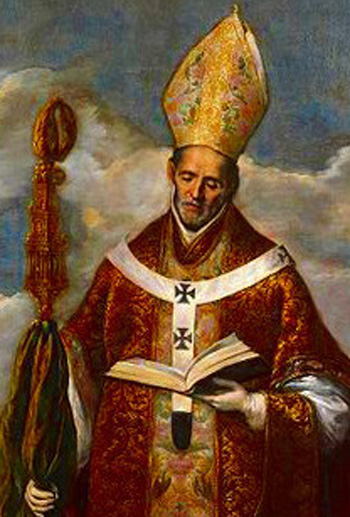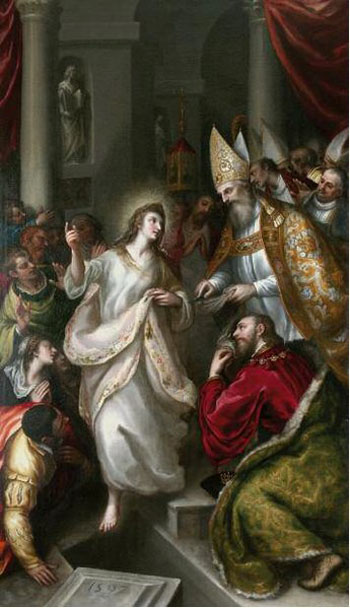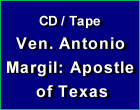Stories & Legends
 |
 |
 |
 |
 |
 |
 |
St. Leocadia Rises from Death
to Praise St. Ildephonsus
St. Ildephonsus, Bishop of Toledo in the 7th century, is known for his great devotion to the Mother of God. He could scarce mention the Divine Savior without some praise for His Holy Mother escaping his lips.
 His greatest glory lies in his being the Doctor of the Virginity of the Mother of God, for the holy Bishop of Toledo defended this attribute with great zeal and eloquence. As Dom Gueranger notes:
“With profound learning and with fervid eloquence, he proved, against the Jews, that Mary conceived without losing her Virginity. Against the followers of Jovinian, he demonstrated that she was a Virgin in her Delivery. And against the disciples of the heretic Helvidius, he showed that she remained a Virgin after she gave birth to her Divine Son.”
His greatest glory lies in his being the Doctor of the Virginity of the Mother of God, for the holy Bishop of Toledo defended this attribute with great zeal and eloquence. As Dom Gueranger notes:
“With profound learning and with fervid eloquence, he proved, against the Jews, that Mary conceived without losing her Virginity. Against the followers of Jovinian, he demonstrated that she was a Virgin in her Delivery. And against the disciples of the heretic Helvidius, he showed that she remained a Virgin after she gave birth to her Divine Son.”
His devotion to to Our Lady merited him the honor of a Virgin Martyr rising from her tomb to thank him for this magnificent defense of the perpetual Virginity of the Mother of God. During the time of St. Ildephonsus, devotion to St. Leocadia, a third century Spanish Virgin who won the martyr’s crown in 304 under the Diocletian persecution, was experiencing its time of splendor. A Basilica had been erected in her name in Toledo, and it was there that her blessed remains were venerated by the faithful, who honored her as the patroness of their city.
One year during the time of St. Ildephonsus, the festival of the Saint was being prepared with unusual splendor. On December 9 the clergy, nobility and people gathered in the grounds of the Basilica. The Spanish King Receswind was also present, displaying all his power, and took his seat on his throne.
The beloved Bishop Ildephonsus knelt praying at the foot of the Saint's tomb, completely covered by a solid slab of stone. The singers sang verses and hymns composed by Ildephonsus. Then, suddenly, by the work of invisible hands, the stone was removed and the Virgin Martyr St. Leocadia came forth. The King, Bishops, clergy, nobles and people cried out with one voice glorifying God.
 The Virgin Martyr joined her voice to praise God, and then she praised Bishop Ildephonsus for the services he had rendered to the Mother of God. In the hearing of the whole assembly, she cried out: “O Ildephonsus! Our Lady, the Queen of Heaven, has gained a triumph through thee.”
The Virgin Martyr joined her voice to praise God, and then she praised Bishop Ildephonsus for the services he had rendered to the Mother of God. In the hearing of the whole assembly, she cried out: “O Ildephonsus! Our Lady, the Queen of Heaven, has gained a triumph through thee.”
Meanwhile, the Archbishop, oblivious to the panegyric that was so portentously woven in his honor, saw her retreating to return to her resting place. Boldly he took hold of St. Leocadia's mantle that she wore on her head. Taking hold of the stiletto that hung from King Receswind's waist, he cut off a piece of that garment. With this precious relic, he immediately went on to enrich the sacred treasury of the Church, placing the piece of garment and the King’s dagger there.
St Ildephonsus left several eloquent writings, some of which he never finished, owing to the many troubles and occupations which engrossed his time. He at length made a happy death, after being Bishop nine years and two months, and was buried in the Basilica of St. Leocadia about the year 667, Receswind being then still King of Spain.
During the general occupation of the Kingdom by the Moors in the mid 8th century, his relics were translated to the city of Zamora, and placed in the Church of St. Peter, where they are honored with much devotion by the inhabitants.
The relics of St. Leocadia were transferred to Oviedo, where King Alfonso the Chaste (759-842) erected a Basilica in her honor so that there she could receive the cult of which she had been deprived in Toledo.
Some years afterward they were moved to the Abbey of St. Guislain, near Mons in Hainault in Belgium. They were finally carried back to Toledo with great pomp and placed in the great church there on April 26, 1589.



St. Ildephonsus, renowned for his defense of the Virginity of Our Lady before, during & after birth
His devotion to to Our Lady merited him the honor of a Virgin Martyr rising from her tomb to thank him for this magnificent defense of the perpetual Virginity of the Mother of God. During the time of St. Ildephonsus, devotion to St. Leocadia, a third century Spanish Virgin who won the martyr’s crown in 304 under the Diocletian persecution, was experiencing its time of splendor. A Basilica had been erected in her name in Toledo, and it was there that her blessed remains were venerated by the faithful, who honored her as the patroness of their city.
One year during the time of St. Ildephonsus, the festival of the Saint was being prepared with unusual splendor. On December 9 the clergy, nobility and people gathered in the grounds of the Basilica. The Spanish King Receswind was also present, displaying all his power, and took his seat on his throne.
The beloved Bishop Ildephonsus knelt praying at the foot of the Saint's tomb, completely covered by a solid slab of stone. The singers sang verses and hymns composed by Ildephonsus. Then, suddenly, by the work of invisible hands, the stone was removed and the Virgin Martyr St. Leocadia came forth. The King, Bishops, clergy, nobles and people cried out with one voice glorifying God.

The Bishop took the King's stiletto &
sliced a piece of the Virgin's mantle
Meanwhile, the Archbishop, oblivious to the panegyric that was so portentously woven in his honor, saw her retreating to return to her resting place. Boldly he took hold of St. Leocadia's mantle that she wore on her head. Taking hold of the stiletto that hung from King Receswind's waist, he cut off a piece of that garment. With this precious relic, he immediately went on to enrich the sacred treasury of the Church, placing the piece of garment and the King’s dagger there.
St Ildephonsus left several eloquent writings, some of which he never finished, owing to the many troubles and occupations which engrossed his time. He at length made a happy death, after being Bishop nine years and two months, and was buried in the Basilica of St. Leocadia about the year 667, Receswind being then still King of Spain.
During the general occupation of the Kingdom by the Moors in the mid 8th century, his relics were translated to the city of Zamora, and placed in the Church of St. Peter, where they are honored with much devotion by the inhabitants.
The relics of St. Leocadia were transferred to Oviedo, where King Alfonso the Chaste (759-842) erected a Basilica in her honor so that there she could receive the cult of which she had been deprived in Toledo.
Some years afterward they were moved to the Abbey of St. Guislain, near Mons in Hainault in Belgium. They were finally carried back to Toledo with great pomp and placed in the great church there on April 26, 1589.







